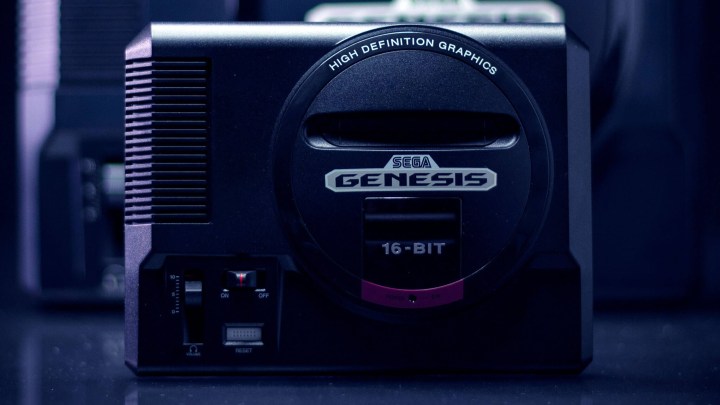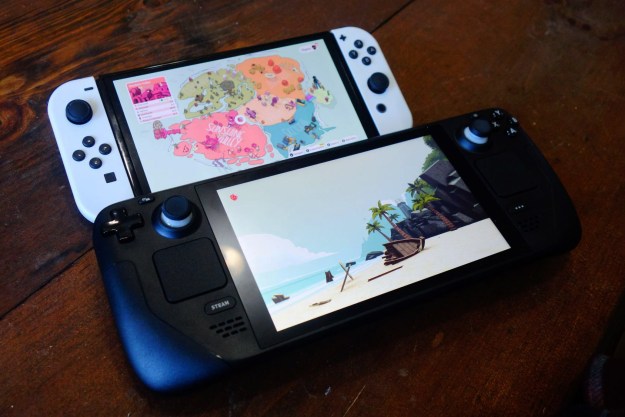
The Sega Genesis Mini has arrived, packing dozens of the best Genesis games into one well-made miniature console. We spent more than a month with the Genesis Mini for our review and came away incredibly impressed with the pint-sized hardware, the emulation, and the library of retro games. We spoke to project lead Hiroyuki Miyazaki, who told us all about the making of the mini console, from choosing the games to staying true to the original.
Digital Trends: How long has the Sega Genesis Mini been in development?
Miyazaki: If you count the period of time that a Mega Drive development team member (a Sega Toys employee) unofficially started research, then it’s been a very long time since development began. However, the project officially started in May 2018.
In terms of design, it appears Sega went to great lengths to mirror the original, at half the size. It even includes a faux cartridge slot, an operable reset button, and volume slider. How important was it to stick with the original design? Did the team run into any challenges replicating the design?
Miyazaki: As the project progressed, the older crowd in the company got together and put in various requests. The more operating parts we wanted, the more costs would rise, along with additional work. So, as the project leader, it was tough making decisions on what to incorporate into the design and what to cut. The one disappointing thing was that we couldn’t use the “CD” mark on the Mega Drive Tower because you’re only allowed to display this mark if CDs are functional.
I noticed during my E3 2019 preview that the controller face buttons have that mushy feeling that was so present in the original. It brought me back to my childhood almost instantly. Are the controllers exact replicas of the originals?
Miyazaki: We tried to replicate everything as true to the original as possible, but of course the parts used are different from the ones back then, so it isn’t an exact replica. If you felt the same feelings you did in the past, I think it might be because the human memory isn’t always 100% accurate.
The Genesis Mini comes with a three-button controller while the Mega Drive comes with a six-button. Can you talk a little bit about this decision? I know Retro-Bit is manufacturing an officially licensed six-button gamepad for North American and European users. But I’m curious if this has something to do with nostalgia.
Miyazaki: It’s true that the six-button controller is easier to use for some of the titles on the Mega Drive Mini. On the other hand, the six-button controller was sold separately in the States, so many people may be more familiar with the three-button controller. After discussing it with the U.S. marketing team, we decided to move forward with the three-button model for the West. Those who really want to experience the six-button model have the option of purchasing the Retro-Bit controller separately.

The emulation was handled by M2, but is it true that all of the little glitches and bugs in the games were kept to adhere to authenticity?
Miyazaki: Yes, this is true. If it doesn’t affect the user experience, we’ve kept the glitches and bugs present in the original. However, there are a few games that had very slow processing speeds in the original versions, so we’ve included different versions with improved clock rates.
There has been no shortage of Sega Genesis retro consoles from third-party manufacturers over the years. As someone who has played those and came away disappointed, can you talk about what the Genesis Mini does that the others didn’t in terms of emulation and design?
Miyazaki: I haven’t touched any third-party manufactured Genesis consoles, whether it be officially licensed or not, so I can’t really comment on this. It wasn’t our goal to create a product to improve upon these third-party products or to measure their differences.
The authentic design goes beyond just the console itself. One thing I noticed at E3 2019 was that the box art and titles of games change based on which region you select. Are there any other little Easter Eggs in the menus?
Miyazaki: The menu system isn’t that complicated, so whatever you saw is probably everything. However, there is a function where if you leave the title selection screen on for a given amount of time, a demo for all the titles will loop. I’m personally quite fond of that function.
I want to talk about the game library, which is pretty massive. What’s the process of coming up with a strong list of games to include? The Sega Genesis and Mega Drive had a huge library of great games and you can’t put them all on the Mini.
Miyazaki: A small group of us led by the Contents Lead, Okunari, chose the titles to put on the Mini. All the candidates were first suggested by Okunari, and I took the lead and made the final decisions during the elimination phase, where we had to cut certain titles for various reasons. It’s not like we had all the time in the world to decide.

I was interested to see some critically acclaimed but largely forgotten games on the list, including Alisia Dragoon, Road Rash II, and Dynamite Headdy. How important was it to include great games that don’t necessarily have the same name recognition as, say, Sonic or Kid Chameleon?
Miyazaki: From the very beginning, we weren’t interested in including games based on how well-recognized they are. One of the biggest factors we considered was if the game had any role in telling the narrative of “the age of the Mega Drive”. The inclusion of Alisia Dragoon and Road Rash II represent the Game Arts and EA brands that we felt were important. Dynamite Headdy is definitely a high-quality game, yet it didn’t receive as much attention as other games, so its inclusion was decided at the very end.
Speaking of name recognition, the Sega Genesis finally has Tetris. Sega brought Tetris to arcades the year prior to its release on Game Boy, but it was originally supposed to be released on the Mega Drive, right? Is this version of Tetris the one that would’ve been on Mega Drive?
Miyazaki: I’m not going to get too into this, but if there was a Tetris game released on the Mega Drive back in the day, the quality probably would’ve been lower than the one on the Mini. The version of Tetris on the Mini is the highly-acclaimed arcade version of the game recreated with the latest technology.
This is a long shot, but I’ve read a rumor that less than ten copies of Tetris for Sega Mega Drive were printed before it was canceled. If true, any idea what happened to those unreleased cartridges?
Miyazaki: I don’t know. If I did, I probably would have been fired.
Mini consoles have been all the rage in recent years. Would you say the Sega Genesis Mini is geared towards serious Sega fans, casual players who want to relive their childhoods, or both? As a parent, these consoles are a cool way to show my daughter the games I grew up with.
Miyazaki: If the Mega Drive is part of someone’s “childhood memories”, that means they are a core Sega fan. The Mega Drive Mini is a slideshow of memories. It’s nice to reminisce about the past by yourself, but it’s also nice to give your child a little history lesson.
Yuzo Koshiro composed the chiptune level select music. Besides that neat addition, are the sounds and music gamers will hear the same as the originals?
Miyazaki: Koshiro-san has mentioned that he really enjoyed working on this project. The menu music is his homage to the Mega Drive. Though it’s a completely new tune, it’s very reminiscent of game music of that time.
Editors' Recommendations
- The bizarre Sega Genesis Mini 2 is my new favorite retro console
- The ‘mini console’ trend returns this fall with the Sega Genesis Mini 2
- The Onexplayer Mini has me skeptical about the Steam Deck
- Sega Genesis Mini gets a huge price cut just in time for the holidays


